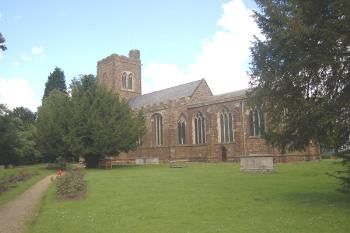Northill College and St Anne's Chantry

Northill church from south east July 2007
Northill College and St Anne’s Chantry
This page was written by Margaret Roberts, Volunteer Historian, Warden Abbey Vineyard.
Foundation of Northill College
Northill College was founded in 1406 for the souls of Sir John Trailly (died 1400) and his son Reginald (died unmarried and childless in 1401 aged just 23 years). It was one of thirty-five English collegiate churches established in the 14th and 15th centuries, fifteen of which took over a parish church and its income from tenants, tithes, offerings, and courts to become self-supporting. Approval for the foundation was granted by Henry IV, but the process took so long that both Pope Innocent VII and his successor, Gregory XII, were involved [HY91].
Master, fellows and choristers
The college was headed by a resident master who received food and drink for himself and one servant, sufficient fodder for two horses, and a stipend (£7 6s 8d was payable in 1526). Each of the four canons (classified as 'fellows' or 'chaplains') was given board and lodging, and a stipend of £6 in return for maintaining prayers and saying masses for the repose of the founders’ family. The statutes also allowed for two choristers who would be provided with food, drink, clothing and education [BHRS, 2, 119; BHRS, 36, 1].
College precinct
Parishioners and chaplains alike worshipped in the parish church on the west side of the lane [TL 1490 4655]. Opposite lay the college precinct of about 5¼ acres [TL 1503 4650] containing living accommodation for the master and fellows, a malthouse, kiln house, two stables, a hay house, three barns, five chambers for storing grain, and a granary for malt. There was a kitchen, a brewery and a bakehouse, a small building for geese, chickens and other fowls, and in the outer yard an old barn. A one-acre orchard contained a dovecote, three ponds and a small well. Also within the precinct was a horse-mill and mill house, both let to a secular tenant [BHRS, 2, 111-13].
Foundation of St Anne’s Chantry
In accordance with the last will of William Fitz, St Anne’s Chantry was established above the church porch in 1494. A chaplain was to celebrate divine services there and to pray for the souls of William, his grandfather (William Risley), and the souls of the founder’s family and friends. The chantry was endowed with ‘All those lands, tenements, meadows, grasslands and pastures, woods, and rents and services in the towns and fields of Beeston, Thorncote, and Hatch called Juells’, but no manse, goods or chattels [BHRS, 2, 121].
Asset valuation
In 1535 the college and chantry received taxable income of £61 5s 8½d and £4 14s 2d respectively [Valor ecclesiasticus, vol. 4, p. 196]. A rental dated to c. 1547 itemised lands held by the college in Northill amounting to £21 7s 1¼d plus half a farthing [BHRS, 2, 113-19].
Dissolution of the chantries
The college was dissolved in accordance with the Abolition of Chantries Act approved by Edward VI in 1547. Its assets were confiscated by the Crown and the church returned to ordinary parochial status. St Anne’s Chantry served as a schoolroom until 1850, and has been used in recent years as a museum for the church and parish [J. Chadwick, [Guide to] St Mary Virgin Northill (1972; revised 1997)].
See this PDF - Northill College for more information.

Parish church of St Mary the Virgin, Northill (July 2016) © M. Roberts